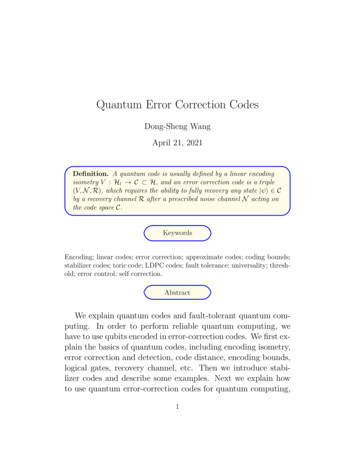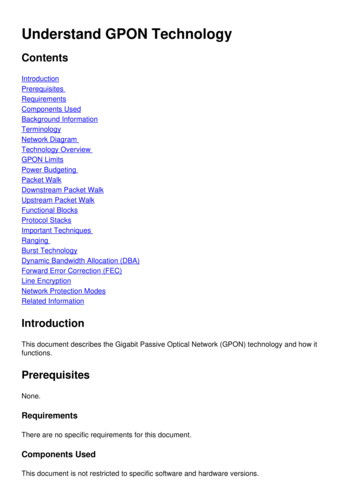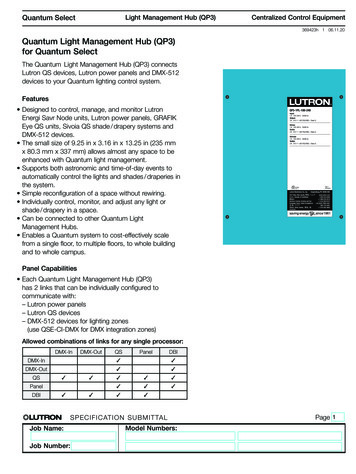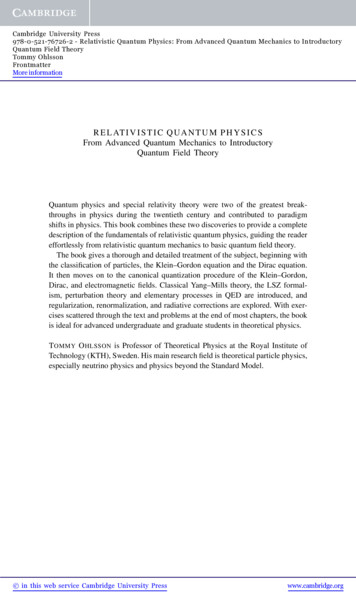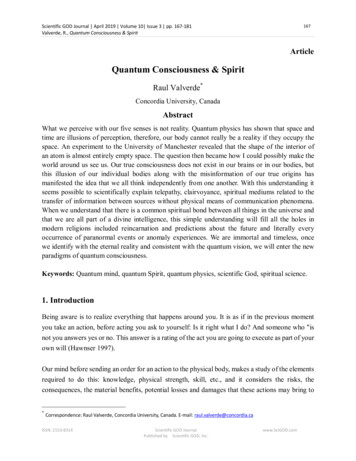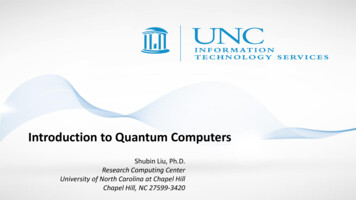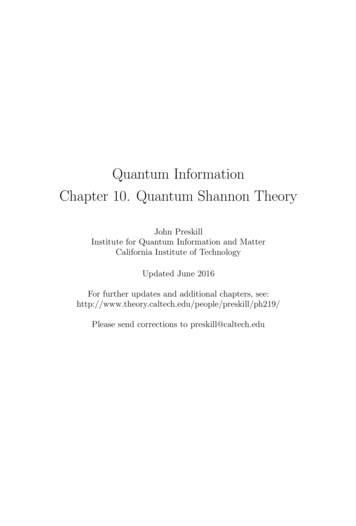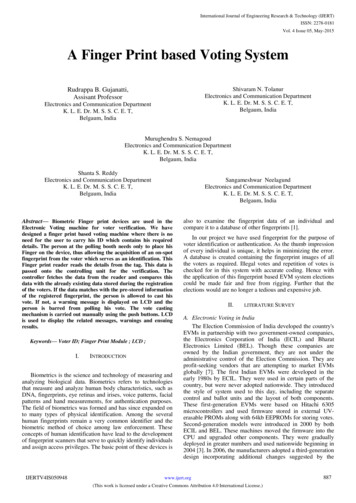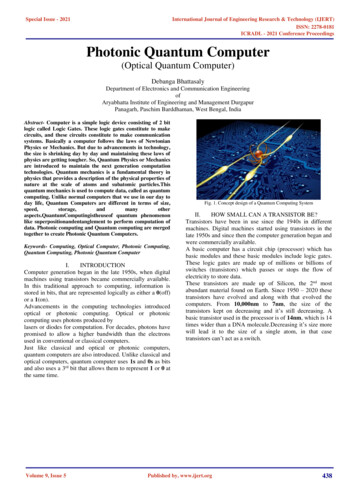
Transcription
Special Issue - 2021International Journal of Engineering Research & Technology (IJERT)ISSN: 2278-0181ICRADL - 2021 Conference ProceedingsPhotonic Quantum Computer(Optical Quantum Computer)Debanga BhattasalyDepartment of Electronics and Communication EngineeringofAryabhatta Institute of Engineering and Management DurgapurPanagarh, Paschim Barddhaman, West Bengal, IndiaAbstract- Computer is a simple logic device consisting of 2 bitlogic called Logic Gates. These logic gates constitute to makecircuits, and these circuits constitute to make communicationsystems. Basically a computer follows the laws of NewtonianPhysics or Mechanics. But due to advancements in technology,the size is shrinking day by day and maintaining these laws ofphysics are getting tougher. So, Quantum Physics or Mechanicsare introduced to maintain the next generation computationtechnologies. Quantum mechanics is a fundamental theory inphysics that provides a description of the physical properties ofnature at the scale of atoms and subatomic particles.Thisquantum mechanics is used to compute data, called as quantumcomputing. Unlike normal computers that we use in our day today life, Quantum Computers are different in terms of utingistheuseof quantum phenomenonlike superpositionandentanglement to perform computation ofdata. Photonic computing and Quantum computing are mergedtogether to create Photonic Quantum Computers.Keywords- Computing, Optical Computer, Photonic Computing,Quantum Computing, Photonic Quantum ComputerI.INTRODUCTIONComputer generation began in the late 1950s, when digitalmachines using transistors became commercially available.In this traditional approach to computing, information isstored in bits, that are represented logically as either a 0(off)or a 1(on).Advancements in the computing technologies introducedoptical or photonic computing. Optical or photoniccomputing uses photons produced bylasers or diodes for computation. For decades, photons havepromised to allow a higher bandwidth than the electronsused in conventional or classical computers.Just like classical and optical or photonic computers,quantum computers are also introduced. Unlike classical andoptical computers, quantum computer uses 1s and 0s as bitsand also uses a 3rd bit that allows them to represent 1 or 0 atthe same time.Volume 9, Issue 5Fig. 1. Concept design of a Quantum Computing SystemII.HOW SMALL CAN A TRANSISTOR BE?Transistors have been in use since the 1940s in differentmachines. Digital machines started using transistors in thelate 1950s and since then the computer generation began andwere commercially available.A basic computer has a circuit chip (processor) which hasbasic modules and these basic modules include logic gates.These logic gates are made up of millions or billions ofswitches (transistors) which passes or stops the flow ofelectricity to store data.These transistors are made up of Silicon, the 2nd mostabundant material found on Earth. Since 1950 – 2020 thesetransistors have evolved and along with that evolved thecomputers. From 10,000nm to 7nm, the size of thetransistors kept on decreasing and it’s still decreasing. Abasic transistor used in the processor is of 14nm, which is 14times wider than a DNA molecule.Decreasing it’s size morewill lead it to the size of a single atom, in that casetransistors can’t act as a switch.Published by, www.ijert.org438
Special Issue - 2021International Journal of Engineering Research & Technology (IJERT)ISSN: 2278-0181ICRADL - 2021 Conference ProceedingsFig. 3. Future of ComputingFig. 2. Evolution of Transistors and ProcessorsIII.FUTURE OF COMPUTINGFrom Classical Computers to Super-computers to Optical orPhotonic Computers to Quantum Computers, computingtechnology evolved. The size of processors is decreasing,which leads to more efficiency, speed and less powerconsumption. Since the size is getting smaller, it’s gettingclose to the size of a single atom, in which case the electronscan’t be stopped for use. This phenomenon in which theelectrons move through the transistors without stopping iscalled “Quantum Tunnelling”. It happens when the size oftransistor is equal to the size of atom. To overcome this,Quantum Computers and Optical Computers are built.Most research projects focus on replacing current computercomponents with optical equivalents. This approach appearsto offer the best short-term prospects for commercial opticalcomputing. For this, electronic transistors are replaced withoptical transistors.Now in case of Quantum Computers, they are believed to beable to quickly solve certain problems that no classicalcomputer could solve in any feasible amount of time—a featknown as "Quantum Supremacy".IV.CLASSICAL BITS VS QUANTUM BITSClassical Computers uses Bits, 0 (off/low) or 1 (on/high) torepresent information logically. Byte is the unit ofinformation storage (1 Byte 8 Bits).1 Byte is enoughto hold 1 typed character like ‘b’, ‘X’, ‘ ’ etc. All storage ismeasured in bytes, despite being very different hardware.Classical Bits have only 2 states (on/off) – 0, 1 which aremutually exclusive. In Classical Bits 0 represents low chargeand 1 represents high charge. The combination of bits islimited.The quantum equivalent of a Classical Bit is called Qubit,which is a two-state quantum mechanical object used inquantum computing. The combination of Qubits isunlimited, because Qubits can’t be defined until the value ismeasured. A Qubit has 2 states, 0 and 1 and a 3rd state whichrepresents 0 or 1at the same time (2n 1 Qubit). Qubitshave 2 states (Ket 0, Ket 1: 0 , 1 ) and they showSuperposition of both states and Quantum Entanglementtogether. To attain or maintain this quantum supremacy,Qubits are kept at low temperatures (0ºK) with magneticfields.In a Pure Qubit State, ѱ a 0 b 1 where a, b arecomplex variables such that 𝒂 𝟐 𝒃 𝟐 1. Therefore,there are 8 possible states per bit.Fig. 4. Classical Bit vs Quantum BitFig. 5. States of BitVolume 9, Issue 5Published by, www.ijert.org439
Special Issue - 2021International Journal of Engineering Research & Technology (IJERT)ISSN: 2278-0181ICRADL - 2021 Conference ProceedingsV.QUANTUM CIRCUITSThe Qubits form quantum gates and these quantum gatestogether form Quantum Circuits. A memory consisting of nbits of information has 2npossiblestates.We begin byconsidering a simple memory consisting of only one bit,𝟏𝟎 0 : ( ); 1 : ( )𝟎𝟏A quantum memory may then be found in any quantumsuperposition of the two classical states 0 and 1 ,𝜶 ѱ : α 0 β 1 (𝜷); α 2 β 2 1The coefficients αandβ are complex numbers, whereas thenumbers α and β are called quantum amplitudes.One important gate for both classical and quantumcomputation is the NOT gate. For 1 Qubit memory,𝟎 𝟏X: ()𝟏 𝟎X 0 1 and X 1 0 The possible states of a two-qubit quantum memory are,𝟏𝟎𝟎𝟎𝟏𝟎 00 : ( ); 01 : ( ); 10 : ( );𝟎𝟎𝟏𝟎𝟎𝟎𝟎𝟎 11 : ( )𝟎𝟏𝟏 𝟎 𝟎 𝟎𝟎 𝟏 𝟎 𝟎CNOT: ()𝟎 𝟎 𝟎 𝟏𝟎 𝟎 𝟏 𝟎CNOT 00 00 ; CNOT 01 01 ;CNOT 10 11 ; CNOT 11 10 Most quantum circuits depict a network consisting only ofquantum logic gates and no measurements.Fig. 6. Quantum CircuitVI.QUANTUM COMPUTERSQubit is the main building block of Quantum Computation.Quantum Computing is the use of quantum phenomenon likeSuperposition and Entanglement for computation.Quantum Superposition states that any two or more-quantumstates can be added together and the result will be anothervalid quantum state.Quantum Entanglement states that the quantum state of anytwo or group of particles separated by a large distancecannot be described independently of the state of the other.Quantum physics describes the behaviour of electrons,protons, neutrons, etc. All of these works on quantummechanics, which helps in Quantum Computing. QuantumVolume 9, Issue 5Computer uses something called as “Fluid QuantumReality”.Computers came all the way down from ClassicalComputers to Super-computers to Optical Computers toMolecular Computers to Atomic Computers to QuantumComputers. In the future, we will not need silicon chips,computers will be running on atoms not on silicon chips.Fig. 7. Regular model of Quantum ComputerVII.CLASSICAL COMPUTER VS QUANTUMCOMPUTERThe main difference between Classical and QuantumComputer is bit. Classical Computers run on Bits whereasQuantum Computers run on Qubits.Classical Computers use linear computation for processing,so it’s slow but could process few tasks for longer period oftime.Quantum Computers use parallel computation forprocessing, so it’s fast and good at multitasking but couldprocess multiple tasks for only a short period of time.FUGAKU is the world’s fastest Super-computer, whileIBM SUMMIT is the world’s 2nd fastest Super-computer tilldate. SYCAMORE is the world’s fastest QuantumComputer developed by Google till date.Since, 1950s to 2021, there had been massive developmentin the computation technologies. We evolved from ClassicalComputers to Quantum Computers but Quantum Computerscan’t replace Classical Computers or Super-computers as ofnow.Published by, www.ijert.org440
Special Issue - 2021International Journal of Engineering Research & Technology (IJERT)ISSN: 2278-0181ICRADL - 2021 Conference ProceedingsFig. 8. Classical Computer vs Quantum ComputerVIII.QUANTUM INTERNETQuantum Internet is sending quantum signals back and forthusing photons through fibre optic cables. These photonsrepresent 0 or 1, and 0 and 1 at the same time due toSuperposition and Entanglement. Quantum Internet is greatfor encryption because Quantum Entanglement is used formore security which makes the transfer of data faster thanthe speed light.Quantum Internet will be securing quantum protocols,sending entangled information across campuses or cities,expanding the networks between states and across the wholecountry.USA’s Department of Energy (DoE) developed a blueprintof Quantum Internet.Fig. 9. Schematic diagram of Quantum InternetIX.PHOTONIC QUANTUM COMPUTERSIn classical computers, data transfer and data computationare done with the help of electricity, where more processorsare used for more processing power.In case of Photonic Computing, data transfer and datacomputation are done with the help of light from the visiblespectrum (350nm – 700nm), where parallel computing isused for more processing power.A. Photonics: Why now?Break through advances in photonic chip fabrication, opticaltelecommunication technology and architecture scaling isthe reason why photonics is used.B. Gaussian Boson Sampling (GBS)A light source is sent through an integrated photonic chip,then it is detected by photonic number detectors and sent forfurther post processing. GBS could solve Dense Subgraph,Maximum Clique, Point Process, Graph Similarity, VibronicSpectra, Quantum Enhanced Feature.Volume 9, Issue 5Fig. 10. Schematic diagram of GBSC. Why Photonic Encoding?Qubits from an input quantum state to an output quantumstate are used to transfer data, since it follows quantum laws.Photons have some number of Degrees of Freedom (DoF),so they can be easily manipulated with high precision atabout 99.9% level. Since, photons have no charge at all,they are the fastest information carriers till date.Optical RAMs are 10 times faster than SRAMs and 1000times faster than DRAMs and uses 50% less powerconsumption. Scientists can now switch between electronsand photons in a single transistor, so silicon photonics cantransfer data at 1.2TB/s up to 100m and 200GB/s up to50km. Fibre internet will use photonic wirings for PhotonicComputing.X.UNIVERSAL QUANTUM COMPUTERQuantum Computers use quantum mechanics likeSuperposition and Entanglement, so all the Qubits areconnected to each other. The time up to which informationlasts in a Qubit is called “Coherence Time”. Controlling theQubits and the right architecture is the main difficulty in aQuantum Computer.Companies like Rigetti, IBM, Google are investing inQuantum Chips, which are superconducting Qubits,basically silicon chips kept at a very low temperature, so thatelectrical and electronic resistance is zero.Performance numbers are not good enough to build a fullyfunctional and operational Photonic Quantum Computer,companies like Amazon, Microsoft, Rigetti, D-wave,Google, IBM, Xanadu are still working on it. TodayQuantum Computers are where Classical Computers used tobe at the beginning years back.Fig. 11. Regular Quantum ProcessorXI.APPLICATIONSThere are various applications of Photonic QuantumComputers like Weather Explorations, Traffic Monitoring,Published by, www.ijert.org441
Special Issue - 2021International Journal of Engineering Research & Technology (IJERT)ISSN: 2278-0181ICRADL - 2021 Conference ProceedingsSpace Communications, Manuscript Decrypting, QuantumEncryption, Drug Development, Teleportation ocessing, Financial Analysis, Medical Analysis, Defence,Oil and Energy, Banking, Chemistry, Logistics, MachineLearning, etc.REFERENCES[1] C. Escoda, “Photonic Quantum Computers,” in Portland QuantumComputing Meetup, 20 Jan 2021.[2] “Photonic Chips,” ble:[3] S. Ghose, “Quantum Computer,” in TED, 1 February, 2019.XII.ADVANTAGES AND DISADVANTAGESA. Advantages Accessible, scalable, versatile and resourceefficient. Modular and customisable. Well suited for distributed quantum computing. Friendly to environment. Unparallel robustness against noise. Highest possible clock rates. Arbitrary connectivity. No cryogenics and Vacuum systems.B. DisadvantagesDefault photon sources are probabilistic.Entanglement operations are also probabilistic.Photon loss.Costly to develop.The materials are lossy.[4] “Hype over Quantum Computers,” 11 January 2020. [Online].Available: https://www.cnbc.com.[5] “Linear Optical Quantum Computing,” NPTEL.[6] Z. Vernon, “Photonic Quantum Computers,” in Q2B 2019, 2019.[7] A. Trounson, “Quantum Leap in Computer Simulation,” 26 june 2018.[Online]. Available: https://www.pursuit.unimelb.edu.au.[8] N. Al-Rodhan, “Quantum Computers and New Space race,” 20 June2018. [Online]. Available: www.nationalinterest.org.[9] D. M. Kaku, Interviewee, The Future of Quantum Computing.[Interview]. 29 September 2010.[10] Quantum Mechanics: The Theoretical Reality.[11] “Quantum Entanglement Lab,” Scientific American, 21 March, 2013.[12] “10GHz OpticalTransistor Builtwww.technologyreview.com, 30 April, 2012.[13] N. P. Laboratory, “Scientists createwww.phys.org, 16 March, 2018.outdiodesofoutSilicon,”of light,”XIII.CONCLUSIONComputers were from 1950s till date and since then therewere many fixes, developments, innovations andtechnological advancements.As technology grows, the need for more power and speedwill undoubtedly grow along with it. The principal concernof Quantum Computer comes from the fact that it involvesthe use of Qubits. So, Photonic Quantum Computers arebeing developed as of now because it uses Photons.Clearly the future of computing lies in Quantum Computingand it shows a lot of potential for future uses. With furtherresearch and experiments, Quantum Computers could beused everywhere. The world needs 1000s of connectedQubits to tackle useful problems. This is why there’s somuch interest, even though it’s so far down the road, but forthis to occur we have a long way to go.ACKNOWLEDGMENTI express my deepest compassion for my parents and myfamily members for their encouragement and affectionateco-operation during my research work.Last but not the least my sincere thanks to all the people whohad spent their valuable time to help and explain me with allthat I wanted to know. Words will fall short to describe theirimportance to me. My gratefulness to them and also to theirkind and co-operative attitude throughout journey. I extendmy heartiest thanks to all those respondents, people andwell-wishers who gave their valuable comments,information and suggestions for the validation of this paper.Volume 9, Issue 5Published by, www.ijert.org442
V. QUANTUM CIRCUITS The Qubits form quantum gates and these quantum gates together form Quantum Circuits. A memory consisting of n bits of information has 2npossiblestates.We begin by considering a simple memory consisting of only one bit,
